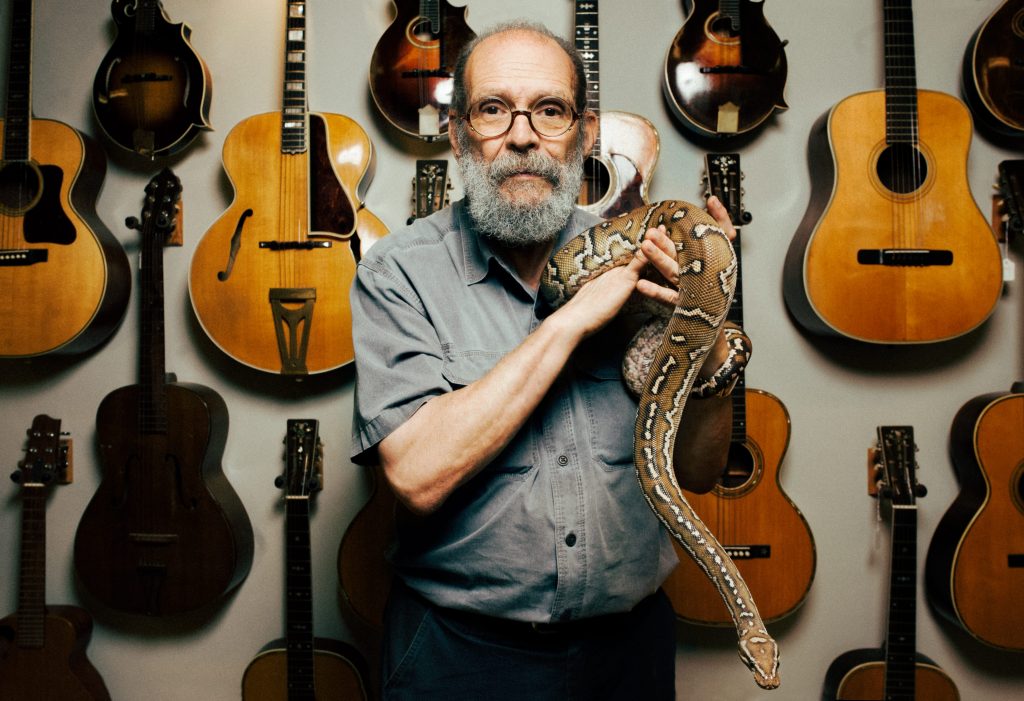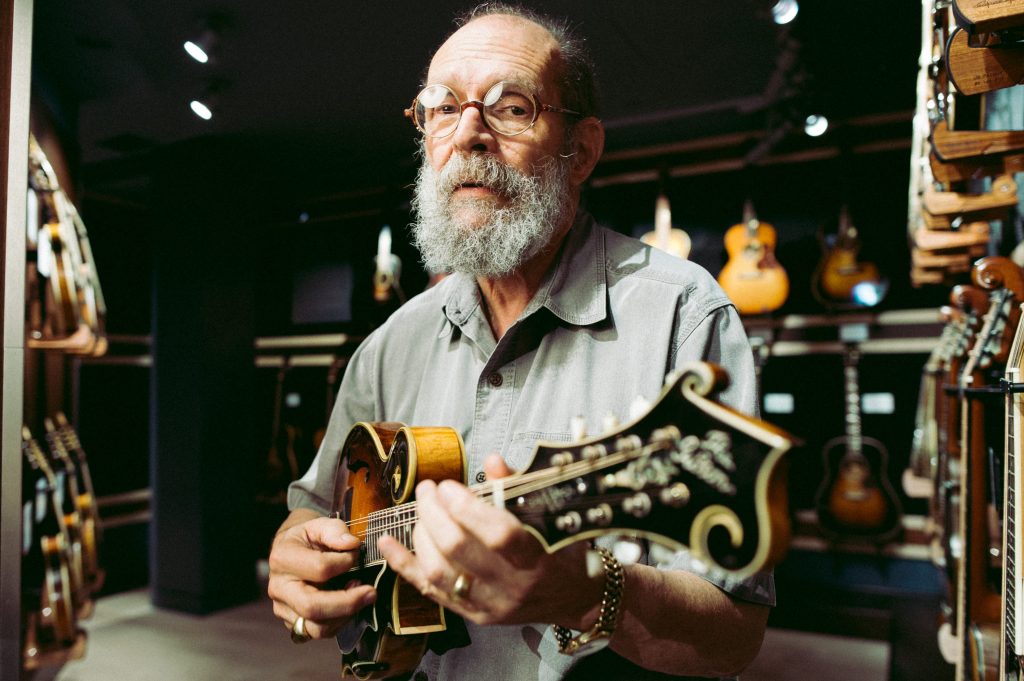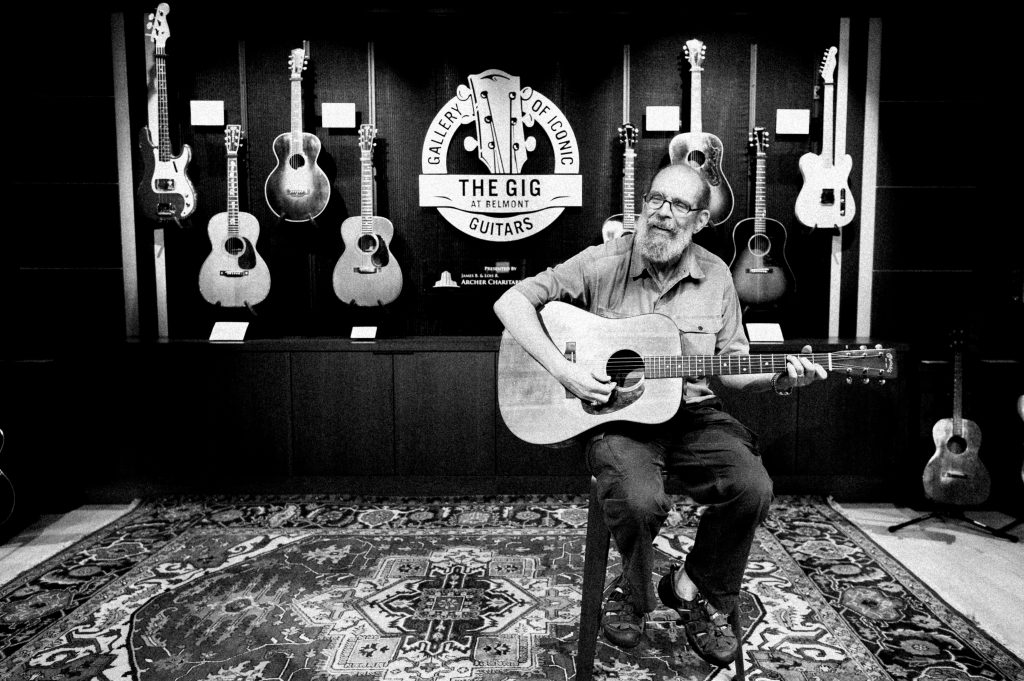
“I never have claimed to be sane. In fact, I believe sanity would be boring, but I’m not sure, never having personally experienced it.”
It’s two days before NAMM’s (the National Association of Music Merchants) annual convention, and Gruhn Guitars founder George Gruhn is leaning against a table in Belmont’s Lila D. Bunch Library, about one hundred feet from Belmont’s Gallery of Iconic Guitars (The GIG). The gallery hosts roughly one hundred vintage stringed instruments, from electric and acoustic guitars to basses, mandolins, and banjos. They’re part of a $10.5 million-dollar collection donated by Steven Kern Shaw, a client and friend of Gruhn’s who passed away in 2015. Along with the other co-executor of Shaw’s will, New York attorney Andy Boose, Gruhn oversaw the completion of The GIG, which not only displays these priceless pieces but also gives you the opportunity to play them (well, a few of them).
But at the moment—as is liable to happen when you’re talking to Gruhn—we’ve gotten a little off-topic. He’s explaining how, as a twenty-year-old psychology student, he made a convincing argument for his own insanity. It was so convincing, actually, that it got him out of Vietnam.
“I can be crazy when I need to be, and I’m not the least bit embarrassed about being certified as crazy,” he says, staring at me through his rounded Armani trifocals. “I think you’d need to be crazy to go to Vietnam back then.”
Even though we’re in a library, Gruhn doesn’t lower his speaking voice. He doesn’t need to: in the five hours we spend together, first at Belmont and then at Gruhn’s new-ish location on 8th Avenue, the seventy-two-year-old never breaks from the same hushed, deadpan cadence. The $175,000 Gibson F5 mandolin in The GIG, climate change, Eric Clapton, Broadway tourists—they’re all discussed in this calculated monotone, each word picked with calm deliberation. Imagine Severus Snape, subtract the acerbic wit, add a little Carl Sagan, and you get an idea of what talking to George Gruhn is like.

If Gruhn sounds more like a scientist than a guitar salesman, that’s because he is. Yes, he owns one of the most prestigious vintage guitar stores in the world. Yes, he’s sold guitars to everyone from Clapton to Paul McCartney to Taylor Swift. And yes, he’s literally written the book(s) on vintage guitars (see: Gruhn’s Guide to Vintage Guitars, Acoustic Guitars and Other Fretted Instruments, Electric Guitars and Basses).
But before the fretted instruments, there was zoology. Gruhn’s passion for the subject started at age four, when he began collecting insects. By the time he was twelve, he’d converted his family’s Pittsburgh basement into a full-fledged menagerie that boasted snakes, frogs, fish, and even a couple of possums. The self-described obsession led Gruhn to a degree in psychology of animal behavior from the University of Chicago and doctoral work at Duke and the University of Tennessee.
However, buying and selling vintage stringed instruments—a hobby he’d developed as a teen—soon became his new obsession. As a twentysomething, he was buying and selling so much that, at the recommendation of Hank Williams Jr. (one of his first high-profile clients), Gruhn ditched school and opened the first iteration of Gruhn Guitars at 111 Fourth Avenue North on Lower Broadway. That was 1969. In 1976, the 20 x 60–foot office moved to 410 Broadway, then down the block to a four-story building at 400 Broadway in 1993. In 2013, Gruhn Guitars moved yet again to its current location on 8th Avenue.
I talked to Gruhn as he gave me a tour of The GIG, showed me his office (complete, perhaps unsurprisingly, with eleven snakes, two cats, and one Australian Bearded Dragon named Freddy), and took me through his private collection of stringed instruments. The following are edited excerpts from our day together.

ON THE CREATION OF THE GIG:
This museum had its start with a collector-customer of mine named Steven Kern Shaw . . . Kern, his middle name, was named [after] his grandfather, Jerome Kern, a very famous Broadway songwriter. He did “Old Man River,” “Smoke Gets in Your Eyes,” and hundreds of tunes which to this very day continue to produce a very considerable royalty income.
[Steven Kern Shaw] had some instruments that were just wheeling-and-dealing stock that he’d pick up in pawn shops. As he was searching for the ones he really wanted to keep, he would uncover sometimes dozens of things that were not particularly good. But they were priced cheap enough that he could buy them and then sometimes use them to trade in for other stuff that was better later.
In some ways, that’s not much different than my own start in business. I was a collector, but as a student, Mommy and Daddy paid for my apartment rent, books, food, and my tuition at the University of Chicago. I couldn’t afford to go out and buy expensive instruments. They were willing to buy me one guitar to get started so I could learn to play. After that, I was on my own. But I had this addiction for guitars and banjos and mandolins, and I would constantly check the classified ads every day . . . For every one I’d find that I wanted to keep, I could turn up twenty or more that were great deals on things I didn’t want.
Steve did the same thing but at a later date . . . The collection here is still a culmination of at least thirty-five years of collecting. And what you see here is by no means the whole collection. There were over five hundred instruments, and there’s only about one hundred on display here. We will put some more display cases in, and hopefully in the future we will even expand the space. We will also add more to the so-called “petting zoo” here instead of just these four instruments that are available to be played. Hopefully, within the next thirty days, we’ll have at least a dozen instruments out for people to play.
With all the instruments that we have—including quite a few that are duplicates but still very good quality—we have the potential to loan some to other institutions. We also have quite a few that are set up in excellent playing order and can be used by students, faculty, and visiting musicians who want to have a chance to try out some really great instruments and possibly use them for performances and recordings here. There’s a lot of potential to be worked out yet. This exhibit has only been open since the start of the summer, so it’s nowhere near a final version yet.

ON THE INSTRUMENTS IN THE GIG:
This was an opportunity to preserve and keep intact the best parts of a spectacular collection—to put it in an institution and in a setting in which temporary fads would not matter. A museum is not something that is established simply for whatever is in vogue at the moment. Museums go on and on and on, longer than the lifetime of any person.
This was to provide a permanent home where [the instruments] would be well cared for. And these instruments, in my opinion at least, transcend time in much the same way that fine art can. In his lifetime, for example, Van Gogh never sold a painting. His brother Theo was supposed to be selling some and never did, and he lied about it a bit. When Vincent found out, it was a crushing blow and it’s one of the reasons he committed suicide finally.
This is a collection that can stay around for many, many years to come. Of course, Van Gogh paintings have certainly appreciated now. If you go to an institution like the Metropolitan Museum of Art in New York or the Art Institute of Chicago, they’re not so concerned with the fad of the moment. They are doing something long term.
These instruments are part of our cultural history . . . Even if they were not a commercial success immediately, they are recognized today as being the iconic and best examples of their kind ever made.

ON COLLECTING:
Collectors typically have a passion, but it’s almost addictive. I can remember when if I hadn’t found a guitar in the past month, I’d almost feel like I was having withdrawal symptoms. I’d need one . . . By the time I was in graduate school, I had a three-room apartment—one room was piled three feet deep with guitar cases. By the time I moved to Nashville at the beginning of ’69, I was up pretty close to the guitar-a-day habit.
I’d just be looking and finding [guitars], but I’d use the same skills that my background in zoology had. The instruments fit well into a Linnaean taxonomic order. My father was a pathologist, so I’d give every instrument the forensic pathological exam to see what had gone on with it. What was happening to that instrument? What had happened to it? Because when you look at one, you want to be able to use the skills of a taxonomist to identify what it is. But you also want the skills of the forensic pathologist to discover not only what it is, but what’s been done to it. How original is it? What parts have been changed, modified, damaged, and repaired? That’s critically important in collectability and value, as well as just utility. So I use those skills from my background every day. I don’t feel that my education is wasted.
ON THE DEATH OF THE ELECTRIC GUITAR, WHICH THE WASHINGTON POST RECENTLY INTERVIEWED HIM ABOUT:
I think it’s somewhat exaggerated in terms of total death, but it is in some ways a shrinking market. I do not anticipate the electric guitar going the way of the accordion . . . If you judge by sale of guitar strings—which people are going to use as long as they’re playing, whether they’re buying guitars or not—guitar string sales are definitely down somewhat, but not dramatically.
What’s happened? Numerous things are happening. The millennial generation does not share all the same interests as baby boomers. A lot of the new music is electronic—it doesn’t even use recognizable instruments—but there’s still plenty that does use guitars. If you have an instrument, such as a guitar, that with proper care can last for several hundred years and has been fully evolved for many years, and then you increase production twentyfold from what it used to be in the mid-1980s, after a while you have a heck of a lot of guitars in excellent condition—that are not obsolete, that are flooding the market—and you may not need to make as many new ones. They last.
On average, people don’t keep a guitar much over fifteen years before selling it. That’s a heck of a lot of used guitars potentially being sold, and they compete for market share with new instruments. The fact is that no, the guitar isn’t just simply dying, but the market does have stress. It has a heck of a lot. Never before, in any period in the history of guitars, have there been so many used guitars competing for market share.
"I have a pretty good-sized ego, but I don’t think I’m going to be remembered quite like Stradivari."
ON LEGACY:
While I think that Gruhn Guitars is very well known and can be considered iconic, it is not as iconic as Gibson, Martin, or Fender. Martin is currently being run still by Chris Martin, a member of the Martin family, sixth generation. There are still makers such as John D’Angelico, who was actively building from 1932 until he died in 1964. He certainly didn’t make as many as Martin, Fender, or Gibson, but he did make a bit over 1,100 guitars and several hundred mandolins, and he is still famous today. Stradivari died in 1737, and his instruments are still highly sought after. He is better known than almost anybody on the Forbes billionaire list.
Do I think that Gruhn Guitars is iconic in that sense? No. Do I think it’s going to be remembered in that way? Not really. I have a pretty good-sized ego, but I don’t think I’m going to be remembered quite like Stradivari. Do I wish that it were? Yes. Do I have the power to make that so? No.
One of the most iconic musical instrument dealers ever was Hill & Sons in London, and today I think what they’re best remembered for is they made some of the best bows ever made for violins . . . They actually were, in some ways, the business model I wanted to be like. They produced some violins, but mostly they were a dealer and they had a reputation as the best violin appraiser in the world. They had a reputation for extremely great, high integrity, that their appraisals actually meant something. And that if they said it was a Stradivari, you could pretty well be sure it really was and they would stand behind it.
The Gallery of Iconic Guitars is now open at Belmont’s Lila D. Bunch Library.



